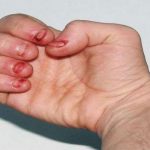 A rare, genetic neurological disorder characterized by self-mutilating behaviors such as head banging and/or lip and finger biting, uncontrolled spastic muscle movements, and involuntary movements of the upper extremities. Moderate intellectual disability is also common.
A rare, genetic neurological disorder characterized by self-mutilating behaviors such as head banging and/or lip and finger biting, uncontrolled spastic muscle movements, and involuntary movements of the upper extremities. Moderate intellectual disability is also common.
A relatively rare genetic disease characterized by mental retardation and compulsive self-mutilation accompanied by uremia.
A rare genetic disorder in boys caused by a lack of the enzyme HPRT. Symptoms include uncontrolled muscle movements and learning disabilities, and life expectancy is 20 — 25.
A rare genetic disease affecting only males that is due to a mutation in the gene for hypoxanthine-guanine phosphoribosyl transferase, an enzyme that is essential in making guanosine from the purine guanine. The disorder is characterized by mental retardation, self-mutilation, and renal failure.
Lesch-Nyhan syndrome is characterized by neuromuscular difficulties such as dystonia and spasticity; speech impairment; renal disease; gout; cognitive deficits; and compulsive, self-injurious behavior. The syndrome was first reported in 1963 by Micheal Lesch and William Nyhan. Lesch-Nyhan syndrome is an X-linked recessive disorder of the enzyme hypoxanthine-guanine phosphoribosyltransferase or HPRT. There are several mutations resulting in the HPRT deficiency, making early diagnosis difficult. The disorder typically affects males because the defective gene is recessive and carried on the X chromosome. Females rarely exhibit characteristics of Lesch-Nyhan, but they may be carriers.
